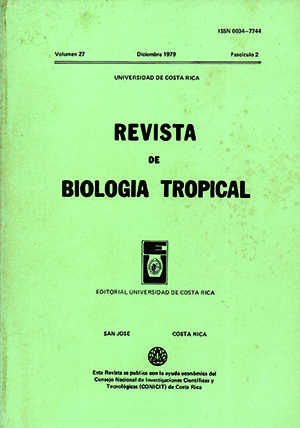Abstract
The spider Philoponella semiplumosa in NW Costa Rica lives both alone and in colonial webs, with the relative numbers of solitary and colonial individuals differing in different habitats. Interactions between colonial individuals when prey fell in the web were sometimes competitive with larger spiders consistenly dominating and sometimes altruistic, with larger ones allowing others to enter their webs and capture prey there. Solitary individuals constructed stabilimenta more frequently, and may thus be subject to greater predation than colonial spiders. Colonial spiders of large sizes spun smaller webs than equal-sized solitary individuals. Nevertheless, the rates of prey capture were the same for solitary and colonial individuals in one habitat, suggesting that colonial life may increase predatory efficiency. Migration rates into and away from colonies were high (averaging from 40-80% per day), but the tendencies for spiders of certain sizes to clump non-randomly suggest that members of colonies may tend to be relatively highly related genetically. The balance of selective factors favoring solitary or colonial life in this species is probably complex.
References
Burgess, J.W. 1978. Social behavior in group-living spider species, p. 69-78. In P. Merrett (ed.). Arachnology. Academic Press, New York.
Buskirk, R.E. 1975. Coloniality, activity patterns and feeding in a tropical orb-weaving spider. Ecology, 56: 1314-1328.
Darchen, R., & J.C. Ledoux. 1978. Achaearanea disparata, araignée sociale du Gabon, synonyme ou espece jumelle d 'A . tessellata, solitaire. Rev. Arachnol., 1: 121-132.
Eberhard, W.G. 1973. Stabilimenta on the webs of Uloborus diversus (Araneae: Uloboridae) and other spiders. J. Zool., Lond., 171: 367-384.
Kullmann, E. 1972. Evolution of social behavior in spiders (Araneae; Eresidae and Theridiidae). Amer. Zool., 12: 419-426.
Lubin, Y.D., W. Eberhard, & G. Montgomery. 1978. Webs of Miagrammopes (Araneae: Uloboridae) in the neotropics. Psyche, 85: 1-23.
Peters, H. 1953. Beitriige zur vergleichenden Ethologie und tlkologie tropischer Webespinnen. Z. Morph. Okol. Tiere., 42: 278-306.
Shear, W. 1970. The evolution of social phenomena in spiders. Bull. Brit. Arachnol. Soc., 1: 65-76.
West Eberhard, M.J. 1975. The eyolution of social behavior by kin selection. Quart. Rev. Biol., 50: 1-33.
Wilson, E.O. 1971. The insect societies. Belknap Press, Cambridge, Mass. 548 p.
##plugins.facebook.comentarios##

This work is licensed under a Creative Commons Attribution 4.0 International License.
Copyright (c) 1979 Revista de Biología Tropical


